Za Krizen 2020 Through the Eyes of Vrbanj Cross-Bearer Matteo Bratanic (Interview)
April 22, 2020 - The 500-year-old UNESCO Za Krizen procession on Hvar was one of the only events to take place in Croatia this month. An in-depth interview behind the scenes with Vrbanj cross-bearer, Matteo Bratanic.
In 1943, the Italian fascists limited it to just 12 people per procession, and in 1944, it took place in a refugee camp in the Sinai desert in Egypt. For more than 500 years, the Za Krizen procession on Hvar, which became inscribed as UNESCO intangible heritage in 2009, has taken place each year since 1510, with six simultaneous processions from Jelsa, Pitve, Vrisnik, Svirce, Vrbanj and Vrboska following a shoeless cross-bearer on an overnight, 25-kilometre pilgrimage of reflection and prayer. And while almost all events in Croatia have been cancelled this month, Za Krizen was controversially given permission to go ahead, albeit in much-reduced circumstances. Whereas hundreds or even thousands take part each year, Za Krizen 2020 was limited to just 15 people per procession.
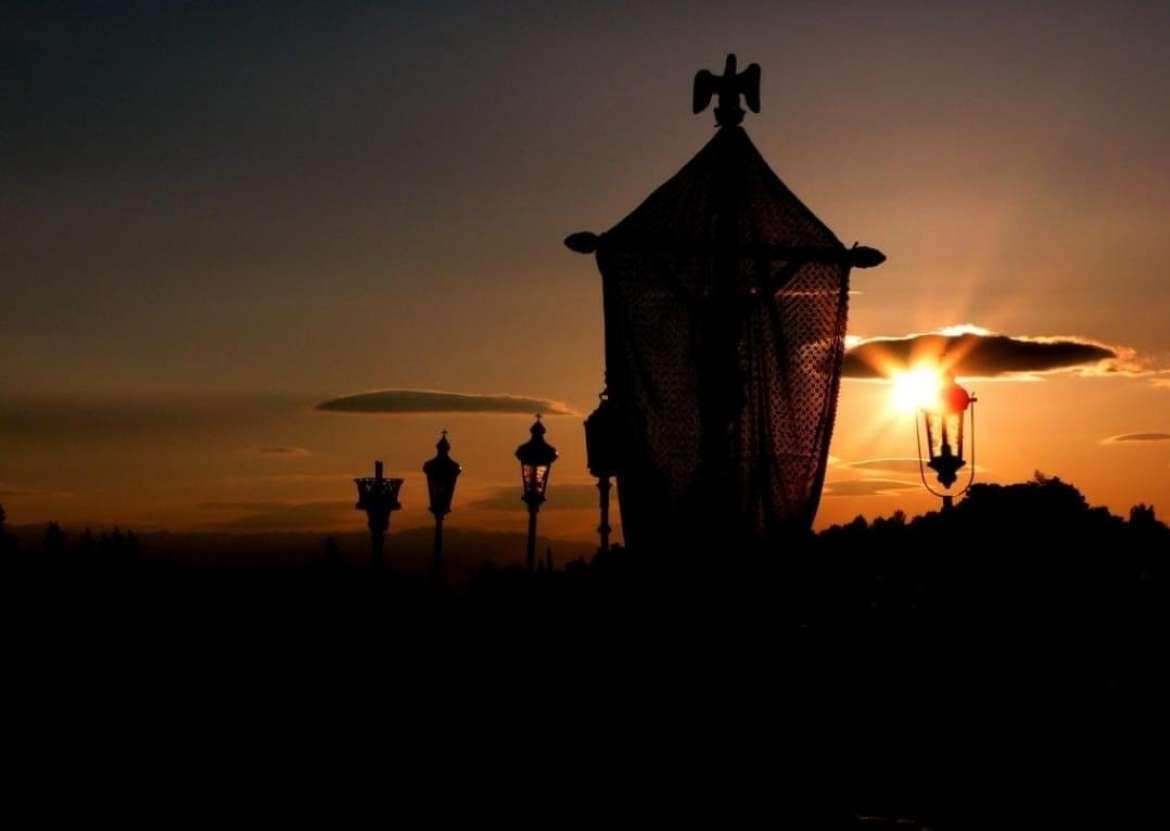
TCN was one of the few eye-witnesses of Za Krizen 2020. You an see our detailed account in Jelsa Za Krizen, Croatia Not Wuhan, & Cabin Fever Perspectives.
So what was it like to carry the cross in this most unusual Za Krizen year, and what was the story behind the scenes? I am very grateful to Vrbanj cross-bearer Matteo Bratanic for this fascinating and comprehensive view of this year's procession, preparations and aftermath through the eyes of one of the six men who carried the cross. Matteo Bratanic was the cross-bearer for Vrbanj.
Tell us firstly when you signed up to carry the Vrbanj cross? How long ago?

I wasn't actually the one who signed myself up to carry the Vrbanj cross. It was my late grandfather who did in 2000 when my uncle, Dr. Andre Bratanic carried the cross. I was 14 months old. Unfortunately, my grandfather, who signed me up, passed away in September of last year and didn't get the chance to see me completing his wish.
In a normal year, how would preparations look like?
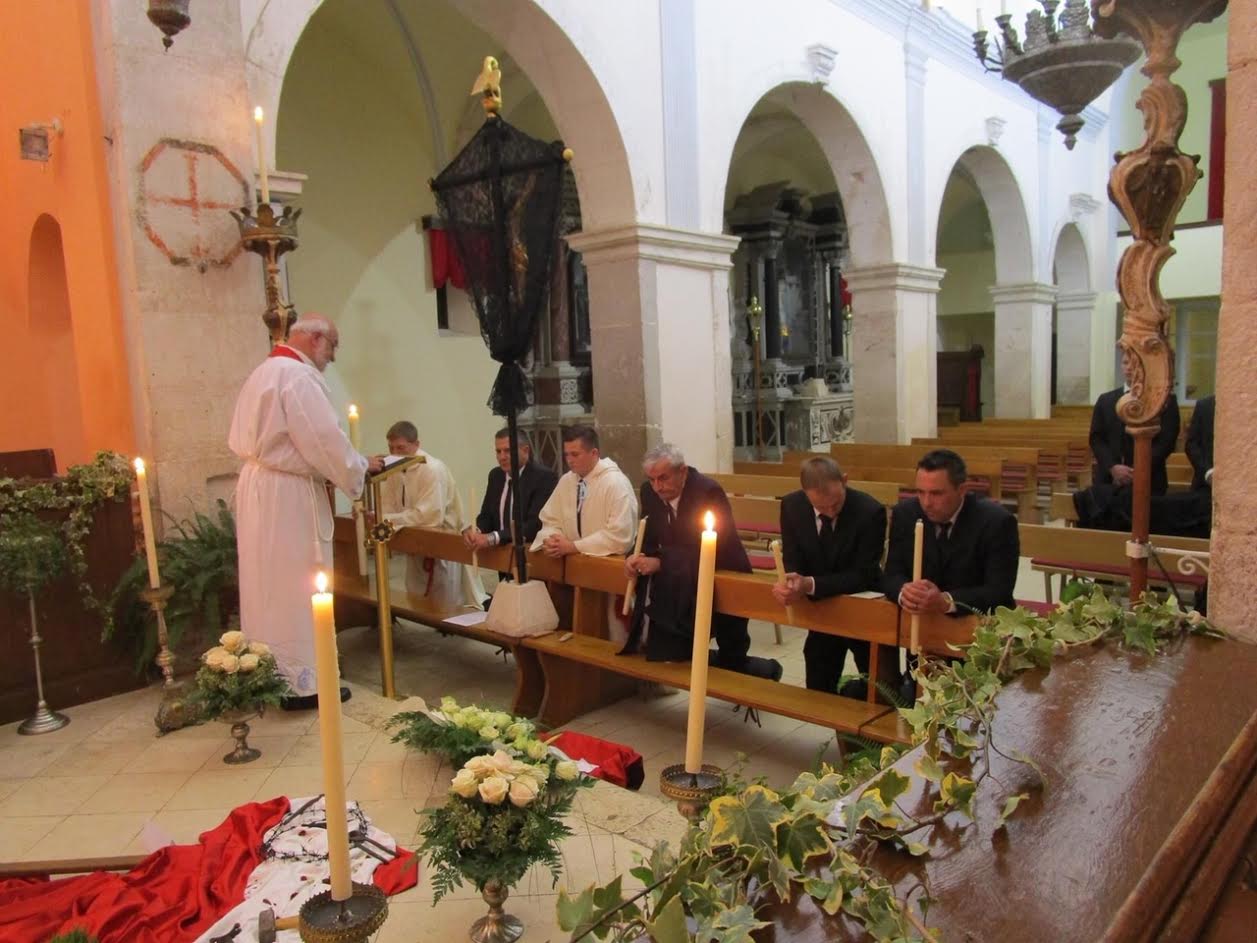
How do you prepare yourself mentally and physically?
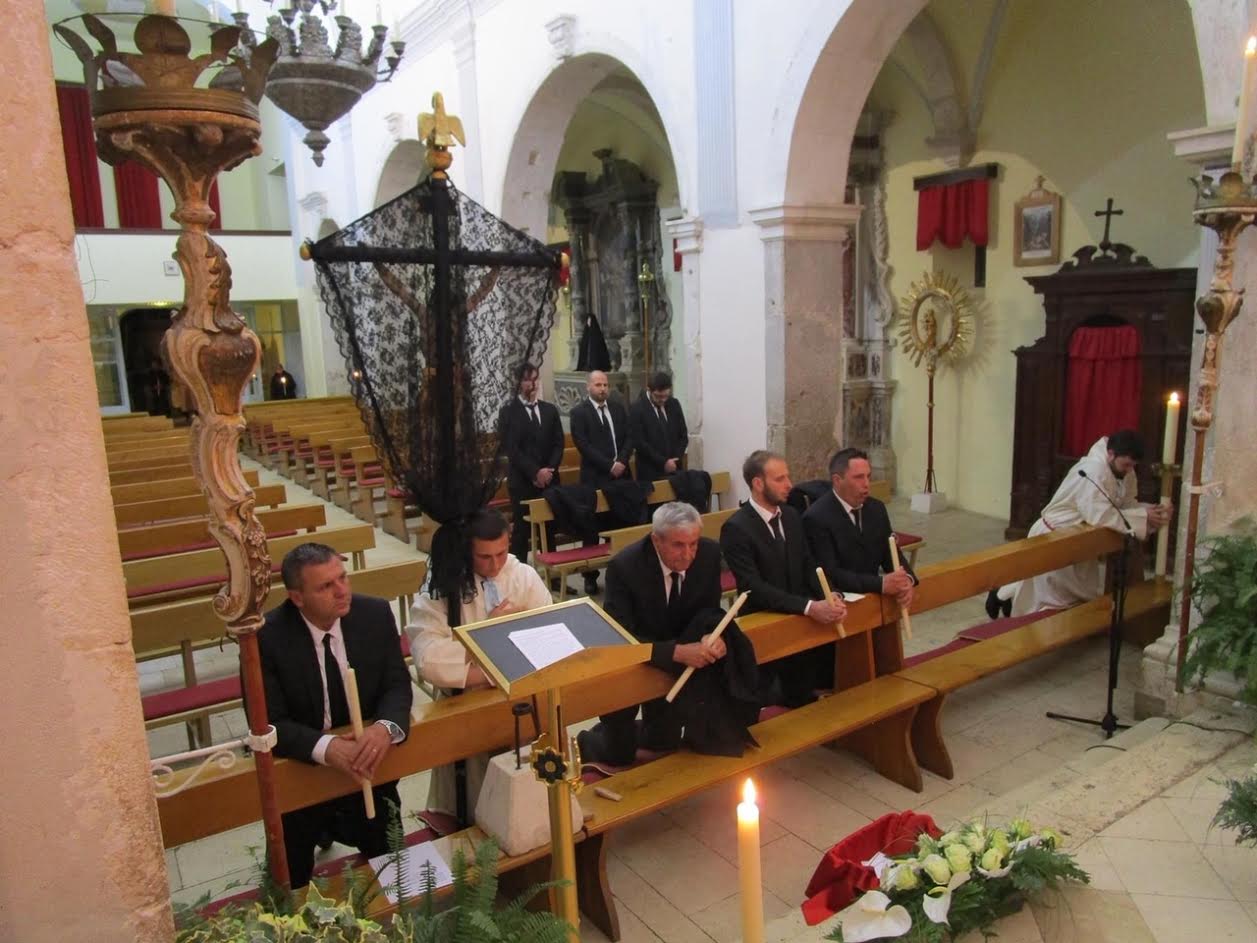
This was not a normal year. When did you realise that Za Krizen 2020 would not be like previous years, if it went ahead at all?
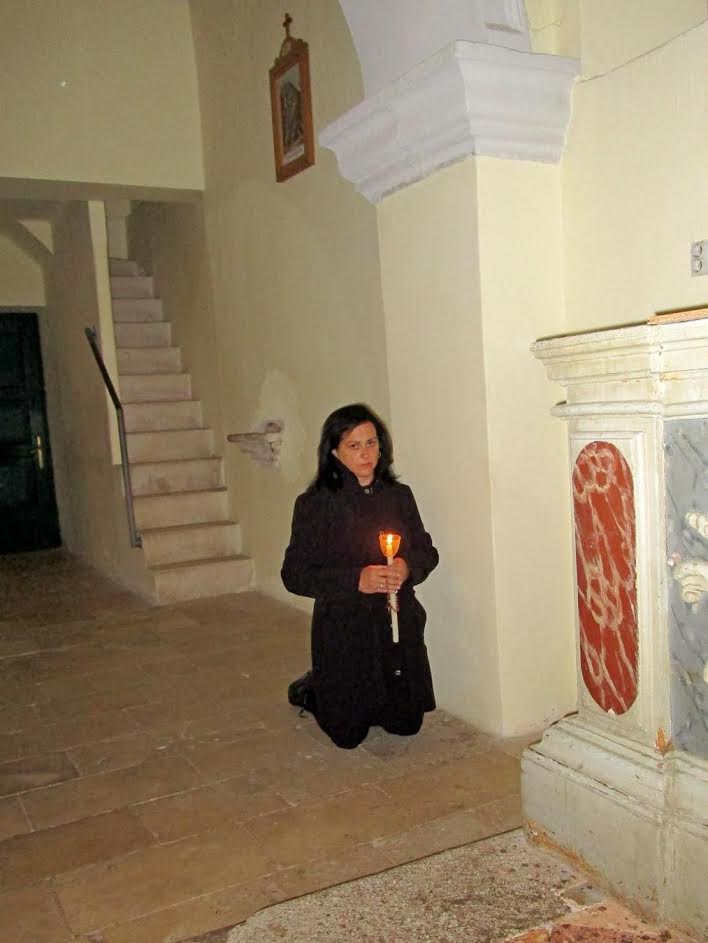
Tell us about your emotions as discussions went to the desk of the Prime Minister.
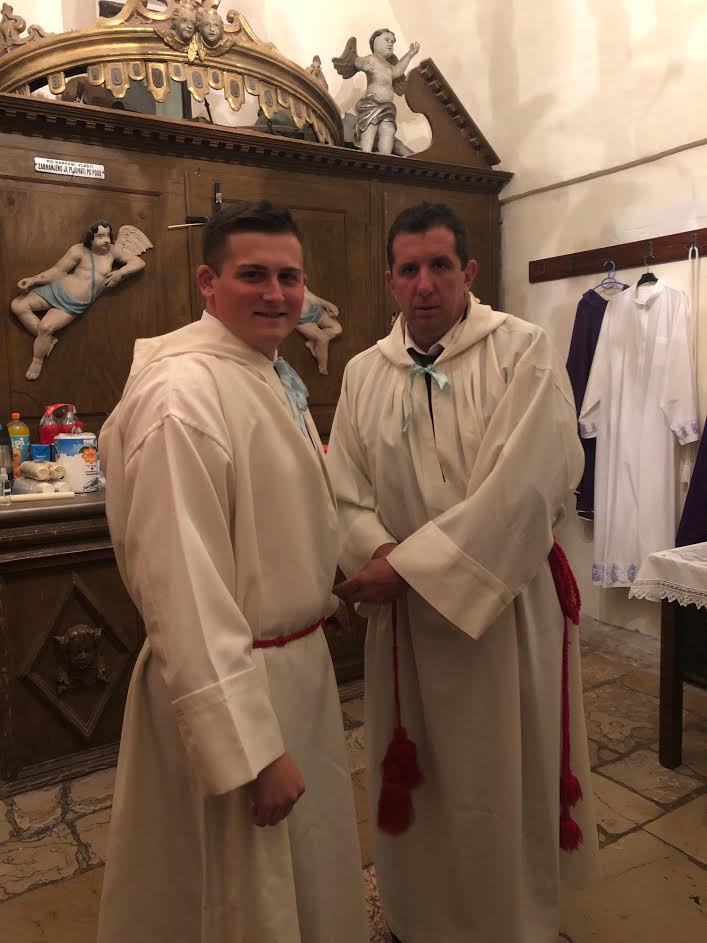
How were discussions about how to proceed, and how close was it to being cancelled?
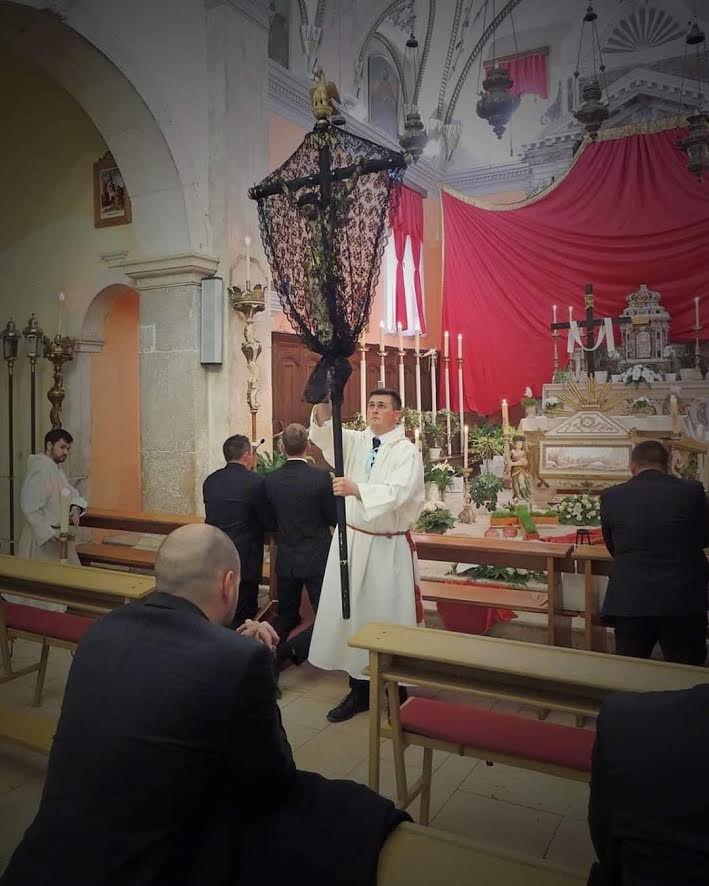
There was a lot of anger elsewhere in Croatia that Za Krizen was allowed to proceed. What do you say to that?
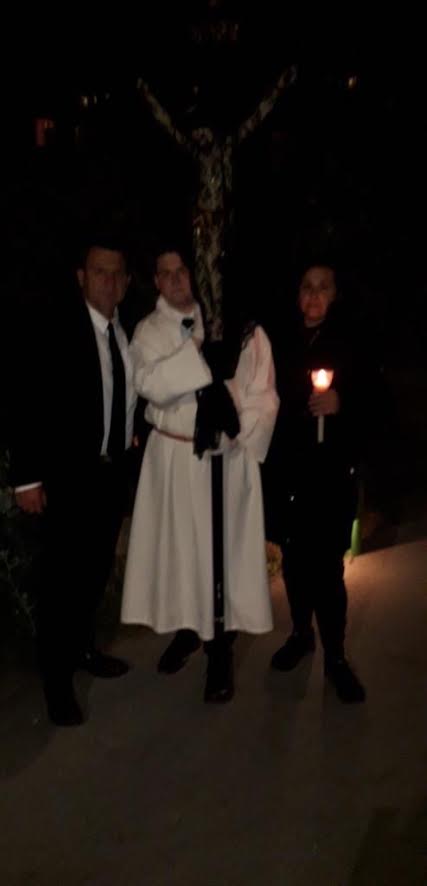
How was the procession for you when it finally went ahead?
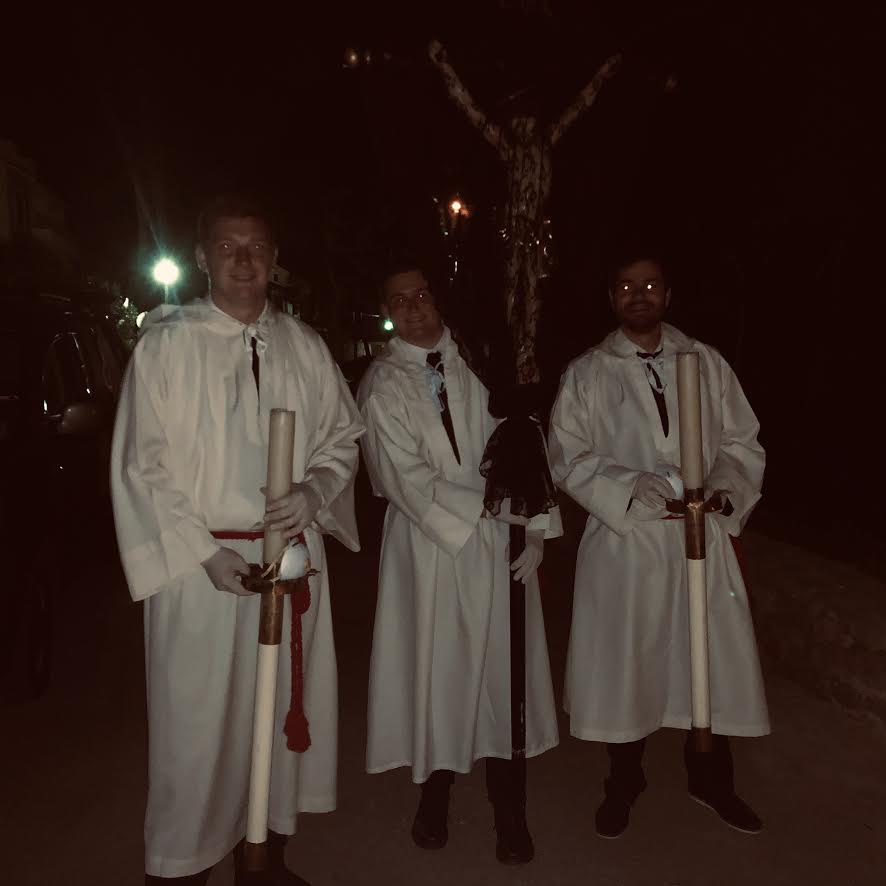
Your family and the people of Vrbanj did a very nice gesture for the earthquake victims of Zagreb. Tell us about 'Varbonj za Zagreb.'
And how do you feel now, 2 weeks later? It must have been an incredibly emotional time for you.
(Hvar TV with the 2012 Pitve cross-bearer behind the scenes - fascinating report)
Croatian Chamber of Commerce Calls for Changes to Measures for Shops
The Croatian Chamber of Commerce (HGK) has started to get itchy feet in the face of the stringent anti-epidemic measures put into place by the Croatian Government and the National Civil Protection Headquarters. The opening hours for shops are giving them the biggest headache.
As Poslovni Dnevnik writes on the 22nd of April, 2020, Croatian wholesale trade has dropped significantly, more precisely from 8.1 percent (from 9.6 billion kuna down to 8.9 billion kuna) in the previous month compared to March last year, while the situation in the retail trade was slightly better as the amount of fiscal receipts issued decreased by just 2.9 per cent, from 7.3 billion kuna down to 7.1 billion kuna.
The Croatian Chamber of Commerce has asked the National Civil Protection Headquarters to lift the current coronavirus restrictions on the operation of all Croatian shops.
"The current favourable epidemiological picture makes it possible for us to be able to open all stores, of course, with the strict implementation of the necessary epidemiological measures. These days, more and more people are returning to work, and most aren't managing to arrive at stores until 17:00, which puts unnecessary pressure on both the stores and on the health of the crowds of people waiting. Re-introducing normal working hours would optimise this and benefit the whole economy,'' said the Croatian Chamber of Commerce's Vice President for Trade and Finance, Josip Zaher, adding that security measures should be determined by the number of visitors relative to the square footage of the shop's premises.
"This will enable the opening of almost all stores without any discrimination, and special attention should be paid to the opening of large shopping centres due to the large fluctuation of customers," Zaher explained, noting that trade is an extremely important activity for the Croatian economy and that we should enable the normalisation of the conditions for it as soon as possible, in order to try to stem the decline in Croatia's economic activity.
Make sure to follow our dedicated section for all you need to know about coronavirus in Croatia. Follow our business page for more on the Croatian economy.
Coronavirus: Interest-Free Government Loans Available to Cities, Municipalities
As Vedran Marjanovic/Novac writes on the 22nd of April, 2020, shortfalls in the budgets of various Croatian counties, cities, municipalities and state funds created through the measures put in place to assist the economy and residents affected by coronavirus will have interest-free loans from the state made available to them, according to a statement issued by Finance Minister Zdravko Maric recently.
''This instruction applies to all local and regional self-government units, the Croatian Health Insurance Institute and the Croatian Pension Insurance Institute, which have experienced falls in revenue due to deferred payments, reimbursement or exemption from income tax and surtax, in accordance with the special regulation governing the general tax procedure,'' reads Minister Maric's statement.
The Ministry of Finance has published the proper forms for applying for these aforementioned interest-free loans on its website.
According to an announcement from the Association of Cities, the aforementioned assistance offered by the Croatian Government doesn't regard loans from commercial banks, but rather temporary assistance for liquidity from the Croatian state budget itself. According to that same association, the amount of credit or assistance offered will be determined by the Ministry of Finance itself according to the amount of deferred, rescheduled and written-off tax liabilities for 2019.
Minister Maric's instructions provided for the payment of these interest-free loans to various beneficiaries in two monthly installments. The first payments of interest-free loans are expected by the end of April 2020.
It's worth recalling that the possibility of paying interest-free loans to Croatian counties, cities and municipalities, as well as state funds, was introduced by the state into the Law on Execution of the State Budget for 2020 in two amendments to that particular law, implemented by the Government and Parliament since Croatia introduced extraordinary measures to protect against the spread of coronavirus.
Make sure to follow our dedicated section for more on coronavirus in Croatia. Follow our business page for more stories like this one.
Analysis: Coronavirus in Croatia Compared to Other European Countries — April 21 Update
April 22, 2020 — A graph showing the number of deaths from or with the SARS-CoV-2 virus per million population per country places Croatia among the five best-ranked countries with the lowest proportional death toll, according to the Johns Hopkins coronavirus database. In addition to Croatia, there are Greece, Poland, Bulgaria and - according to the available data - Slovakia.
The next group includes the Czech Republic, Hungary, Finland, Romania, Estonia, Norway and Slovenia, with the worst situation affecting Belgium, Spain, Italy and France.
Compared to Croatia, often due to its access to measures to combat the epidemic, Sweden has about 15 times the death toll per million inhabitants.
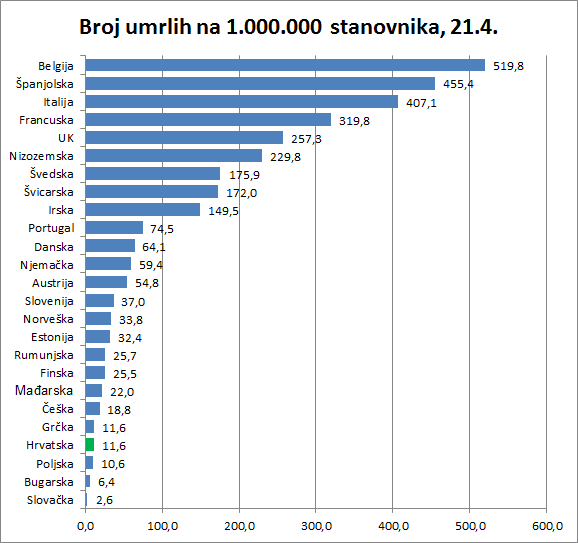
Specifying only the absolute number infected persons or persons who died from or with the presence of the coronavirus does not give a true picture of the situation. There are huge differences in the population of individual states.
In this way, for example, for a very long time, the terrible situation in Belgium, with its 11.5 million inhabitants in absolute numbers (5,998), had seemingly far fewer casualties than, for example, Italy with its 60,5 million inhabitants (24,648).
It can also be said that Germany with 4,961 deaths has far more casualties than 1,765 in Sweden, which is not really the case. On the contrary, Germany with 83.5 million inhabitants is significantly more successful in fighting the epidemic than Sweden with 10 million inhabitants.
Likewise, it is difficult to compare the development of an epidemic by country in parallel if one looks at the number of confirmed infections persons at the same date, regardless of the outbreak of the epidemic in each country. Instead, we provide an overview for each country that starts on the date the infected person was first registered in that country. In this way, it is possible to compare the development and effects anti-epidemic measures both in dynamics and in relative numbers per million inhabitants.
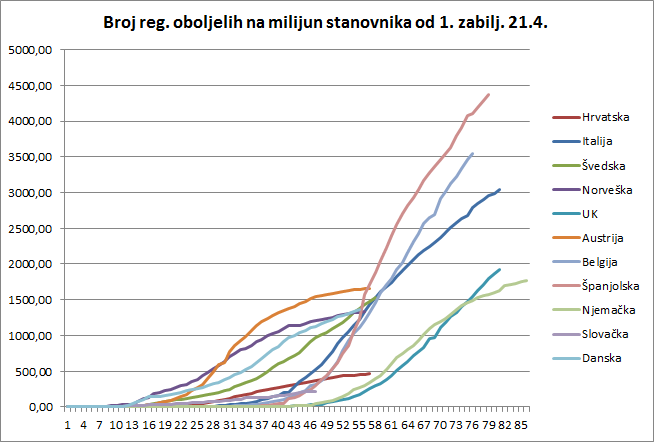
This chart does not show all the countries that were in the previous one, not only because such a view would become completely opaque, but also because of the abundance of data to be monitored.
At first glance, two groups stand out from the countries observed. The left group is one in which the epidemic developed relatively quickly after the first registered infected person in terms of population: Austria, Norway, Denmark, Sweden, Croatia and Slovakia. Of course, these are smaller countries. The right group is one in which more time has elapsed since the first registration of the infected person, and these are countries with a larger population.
In the first group, there was a rapid increase in the number of people infected in Austria, but also a very rapid response that reversed the epidemic as early as the 32nd day, and even without "leveling”, a consistent reduction in the number of new infections was achieved. The epidemic has calmed down after about 50 days in that country, which of course has a great impact on deciding what to do next.
The epidemic in Norway, with an even sharper start, had a similar course. The rapid reaction of the authorities reversed the trend around the 32nd day as well and achieved a calming epidemic around the 45th day.
In Denmark, the epidemic started very similar to that in Norway, but the epidemic’s spread slowed quickly but soon increased again. Currently, the curve is linear.
The same group is followed by Sweden, which initially did not have rapid growth but, by the 55th day, has grown in the number of registered infected persons and Denmark and Norway, and there is no sign of a slowdown.
Viewed in this chart, Croatia and Slovakia have maintained a very low slope linear curve since the beginning and have the lowest number of registered infected persons per million inhabitants.
The group of larger countries shows the worst situation is in Spain, which after exponential growth until the 56th day of the epidemic in its territory, was able to achieve a linear growth. Then from around the 62nd day, a slightly milder but still large slope with no indication that the epidemic would soon begin to subside.
It is similar in Belgium, which straightened the curve around the 54th day but has since maintained a steady but high (relative) increase in new infections with no indication of calm.
Italy, whose exponential curve started about a week before the one in Spain, reached a more moderate slope of the linear part of the curve around day 49 and shows a slight calming of the epidemic.
Germany, with some time lag compared to the first registered infected person, has achieved a curve similar to Austria, with a change in trend around the 68th day.
After exponential growth, the United Kingdom was able to straighten the curve around day 70, but without a stronger indication of calming.
Let’s look closer to Sweden. We can see a form of exponential growth in the number of infected.
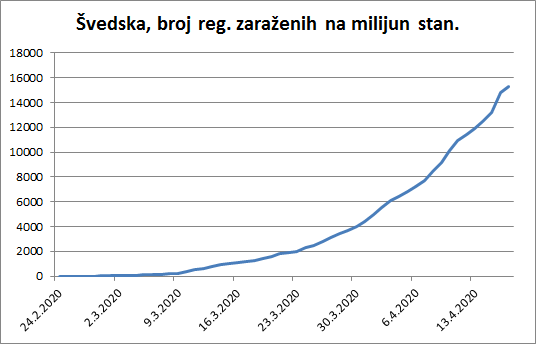
If we take a closer look at Croatia, we will see that linear growth has already been achieved around March 22 (just after the earthquake in Zagreb). An even better curve was achieved after April 1, and that from April 16 it can say it has stifled the epidemic.
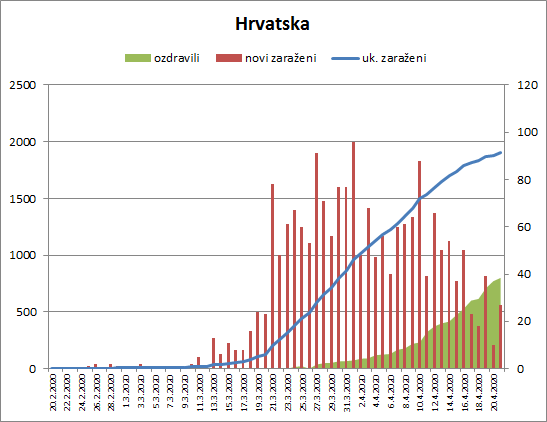
Croatia's excellent result can also be seen in the chart showing the number of patients affected.
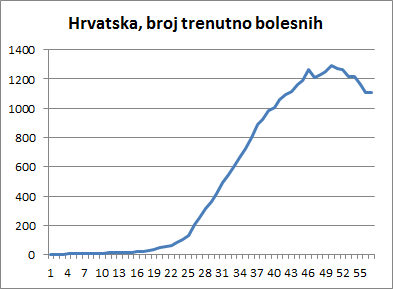
These topics often raise the question of what is a good test measure and whether we are testing enough. An excellent graphical representation of the testing ratio per million population and the percentage of positives shows who optimally tests and who does not. If you are about 10% positive you have found a good measure - Croatia is. Something ugly is coming to Brazil, only if the good weather saves them.
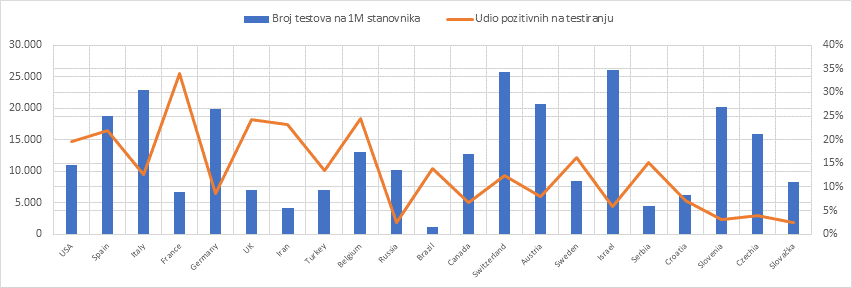 Comparison of the number of tests per million and the percentage of positive ones - by Milan Stevanović 2104
Comparison of the number of tests per million and the percentage of positive ones - by Milan Stevanović 2104
From everything I think it can be concluded how useful it is when policies are established on the basis of scientific knowledge and data. Scientific knowledge, in comparison to the usual political ones, is neither conservative nor radical; they are simply as they are and should be trusted. But these lessons are not exclusively health, but equally political, especially when we talk about loosening up measures.
Of course, any country may be asked what its long-term prospect is in these new circumstances that will not go away. Some countries, which have curbed the epidemic in the sense that they have ensured that their health care system can control the situation, may be far more comfortable developing a further strategy than those who still have to put all their efforts into maintaining the health system's functionality.
And finally - is coronavirus more dangerous than the flu? Yes, but as far as we may know, in just a few months, we learn something new every day. The important difference is that we do not have vaccines and that the virus can mutate more often in a large number of patients.
Krešimir Macan is a public relations professional and political analyst specializing in crisis communications. He has advised two Croatian Prime Ministers, including current Prime Minister Andrej Plenković. He also runs his own PR consultancy, Manjgura.
Krešimir provides TCN with regularly-updated analysis of coronavirus data, helping put Croatia's pandemic response into context.
Jasenovac Victims' Representatives Comment on Joint Commemoration
ZAGREB, April 22, 2020 - The head of the Jewish Community of Zagreb, Ognjen Kraus, said on Wednesday that his attendance at a state-level commemoration for the victims of the Jasenovac concentration camp was an act of readiness to cooperate with the government in dealing with issues that harm Croatia's international reputation.
"I came to extend the hand of friendship and good will and to show that I'm prepared for serious talks on the situation in Croatia and the government's attitude to history," Kraus told reporters covering the event commemorating the 75th anniversary of a breakout of inmates from the World War II Ustasha-run concentration camp.
Kraus confirmed that he saw some progress in the government's attitude to history but that he was more interested in results.
"I'm more interested in results, in finally doing away with the issue of insignia, the issue of historical revisionism and everything that disgraces this country, and I want us to finally start respecting its laws and constitution," said Kraus, noting that he would not attend the state-level commemoration next year if no changes happened by then.
He added that some progress had been made, notably by the ministries of culture and education and that student visits to Jasenovac had been included in school curricula for this year.
A member of the Independent Democratic Serb Party (SDSS), Boris Milošević, said in parliament today that his party was glad that this year a single commemoration was taking place after separate commemorations in the past few years.
He said that the joint commemoration was an act of good will but that that did not mean "giving up the fight against historical revisionism and negation of crimes."
Hrvoje Zekanović of the Croatian Sovereigntists party remarked that one should learn the real and full truth about Jasenovac but that he would also like all participants in the Jasenovac commemoration to start having a proper attitude to the crimes committed in Škabrnja, Vukovar and Bleiburg.
The head of the SABA association of antifascist fighters, Franjo Habulin, said that some progress had been made in the authorities' attitude to antifascism and victims of fascism even though problems accumulated over the past 30 years were not being dealt with at the pace at which SABA would want them to be dealt with.
Habulin recalled that last year's commemoration of the Battle of Sutjeska was held under the prime minister's auspices and that the prime minister delivered very strong messages while opening an exhibition on the Holocaust in Zagreb earlier this year.
Habulin said that this year funds had been secured for visits by 200 classes to Jasenovac and that next year student visits to Jasenovac should become an obligatory part of the history curriculum for all schools.
Activists of the non-parliamentary Workers' Front (RF) party on Wednesday night paid tribute to the Jasenovac victims at a ceremony held near Zagreb's central railway station.
The activists screened an image of the Jasenovac Stone Flower monument and the number of the camp's victims on a locomotive put on display by the central station. The locomotive was used by the Ustasha regime for the transport of people to concentration camps, the RF said.
The party said its commemoration for the 83,145 victims of the camp and its inmates who in 1945 mounted an escape attempt was a symbolic contribution to the culture of remembrance and the fight against historical revisionism, an example of which, it said, was the fact that there was no description of the history of the locomotive on it but only technical details.
More Jasenovac news can be found in the Politics section.
State Leadership, Victims' Representatives Pay Tribute to Jasenovac Victims
ZAGREB, April 22, 2020 - The state leadership and representatives of ethnic minorities and antifascists on Wednesday laid wreaths and flowers at a monument in Jasenovac, paying tribute to the victims of the concentration camp that operated there in WWII and marking the 75th anniversary of an outbreak of its surviving inmates.
Early in the morning of 22 April 1945, the last group of 600 inmates decided to try to break out of the camp, where pro-Nazi Ustasha authorities interned and killed people because of their religion, ethnicity or ideological affiliation. Only 92 inmates survived.
The Jasenovac concentration camp existed 1,337 days during the Second World War, and the Jasenovac memorial centre has identified and gathered information on 83,145 victims - 39,570 men, 23,474 women and 20,101 children aged up to 14 years, who were killed.
This year's state-level commemoration was attended by the entire state leadership, which has not been the case since 2014, as well as by representatives of ethnic minorities and antifascists, who since 2016 had organised separate commemorations, arguing that Croatia is trying to rewrite the history of the Second World War.
A joint wreath was laid at the Stone Flower monument in Jasenovac by President Zoran Milanović, Parliament Speaker Gordan Jandroković and Prime Minister Andrej Plenković.
The parliamentary delegation also included Deputy Speaker Sinisa Hajdaš Dončić of the Social Democratic Party (SDP) and SDP leader Davor Bernardić, while the government delegation also included Culture Minister Nina Obuljen Koržinek. Attending the commemoration was also Ivo Žinić, head of Sisak-Moslavina County where Jasenovac is located.
The head of the Jewish Community of Zagreb, Ognjen Kraus, the head of the Serb National Council advisory board, Milorad Pupovac, Roma minority member of parliament Veljko Kajtazi and the head of the SABA association of antifascist fighters, Franjo Habulin, each laid a flower at the monument.
Due to the current coronavirus epidemic, participants in the ceremony only laid wreaths and flowers, complying with rules of social distancing.
More news about Jasenovac can be found in the Politics section.
Minister Says Quake Damage Estimated at 5.52 Billion Euro
ZAGREB, April 22, 2020 - Construction and Physical Planning Minister Predrag Štromar said on Wednesday that the damage caused by the quake that struck Zagreb and its environs on March 22 had been estimated at 42 billion kuna.
Experts from Zagreb's Civil Engineering Faculty have made five estimates of the damage and chosen the one they think is the most realistic, Štromar said in an interview with Croatian Television.
He said that work on a law to regulate the reconstruction of residential and other buildings damaged in the quake was nearing completion and noted that buildings would be built to accommodate people left without their homes in the quake and that after their flats were rebuilt, those buildings would be used as student dormitories.
Štromar said that money for reconstruction would be sought from the European Commission and World Bank, that a donor conference would be held but that some of the money would have to come from budget reserves as well.
Rebuilding chimneys and restoring heating and hot water is the top priority at the moment, to be followed by the reconstruction of schools, hospitals and other buildings, said the minister.
As for family houses, the minister said that those that were beyond repair would be torn down and that the ministry would help rebuild them.
More news about the earthquake can be found in the Lifestyle section.
Croatia's Government Surplus 1.55 Billion Kuna in 2019
ZAGREB, April 22, 2020 - In 2019, the consolidated general government surplus amounted to HRK 1.55 billion, or 0.4% of GDP, while the consolidated general government debt amounted to HRK 293 billion or 73.2% of GDP, shows a report on the Excessive Deficit Procedure by the national statistics office, published on Wednesday.
In 2018, Croatia saw a consolidated government surplus of HRK 850 million or 0.2% of GDP while the consolidated government debt amounted to HRK 286 billion or 74.4% of GDP.
The official statistics indicate that 2019 was the third consecutive year that the government achieved a general government surplus while the debt to GDP ratio continued to decrease thanks to a nominal increase in GDP.
The surplus was mostly owing to a considerably improved financial result of extrabudgetary beneficiaries and public companies and increased tax revenues.
In 2019, taxes on production and imports totalled HRK 81.3 billion, an increase of 6% on the previous year.
Investments also grew by 27.6% to HRK 17.2 billion but last year was also marked by payments of government guarantees for shipyards amounting to HRK 1.78 billion, which impacted the surplus, DZS said.
At the end of 2019, the consolidated general government debt increased by HRK 6.9 billion, up 2.4% compared to the end of 2018. Of that amount, HRK 5.7 billion was net borrowing while the rest is attributed to positive exchange rate changes in the kuna against the euro.
The debt-to-GDP ratio fell by 1.5 percentage points compared to 2018 and stood at 73.2% of GDP at the end of 2019.
Last year the government adopted a budget based on an expected economic growth of 2.5%, a consolidated general government surplus of 0.2% of GDP or HRK 629 million, and a public debt to GDP ratio of 71.3%, however, with the outbreak of the novel coronavirus, which is seriously affecting the economy, it will be difficult to achieve those goals, the DZS said in its report.
More economy news can be found in the Business section.
Tourism in the Corona Age: 10 Virtual Ways to Discover Hvar
April 22, 2020 - Tourism is on hold, but most of us have plenty of time. So let's look at the virtual resources available to explore Croatia virtually. We begin a new series with the tools to discover Hvar.
A few weeks ago I wrote that being a tourism blogger in the corona era was about as useful as being a cocktail barman in Saudi Arabia. I feel less useless now, a few weeks later, and I am encouraged by the number of Croatian tourism businesses who are contacting us wanting to start thinking of promoting post-corona tourism.
One of the challenges of writing about tourism at the moment is that there is nothing positive to write about. With people confined to their homes and tourism in Croatia currently not possible, many have decided to go into hibernation until it is all over.
I think that this is a mistake, and I have greatly enjoyed the TCN series by Zoran Pejovic of Paradox Hospitality on thinking ahead to tourism in a post-corona world. You can find Zoran's articles here.

Way back on March 14 - several lifetimes ago - I published an article called Tourism in the Corona Age: 10 Virtual Ways to Discover Zagreb. The way I saw things, now was an OUTSTANDING opportunity for tourism promotion. People have time, they yearn for their freedom and former lives, so give them the tools to thoroughly research and enjoy your destinations, and you will have then longing to be there. And when they do come, they will have a deeper understanding of the destination due to their research.
South Africa and Portugal were the first to do their post-corona tourism promotion videos several weeks ago (Post-Corona Tourism Planning: Lessons from South Africa and Portugal), a trick which has been followed by other tourism countries, the latest being Croatia with the national tourist board campaign, #CroatiaLongDistanceLove, going live yesterday.
But while these campaigns create longing and market presence, they don't really educate. People now have time to really get into destinations. And dreams of escape to somewhere more exotic are high on the list of priorities of many.
So TCN has decided to help with that education with a new series called Virtual Croatia, where we will be helping you discover many of Croatia's destinations with all the best virtual tools available on your self-isolating sofa at home.
And in order to help things along, TCN will offer a free article such as this one to any local tourist board which wants to send us their best virtual tools of their destination. If interested, please send all the resources to This email address is being protected from spambots. You need JavaScript enabled to view it. Subject Virtual Croatia (and name of destination).
So where to begin? Where else than my beloved Hvar.
An oldie but a goodie - the Visit Hvar beach tour of the island
It is more than 8 years since Visit Hvar published Island Hvar, My Place in the Sun. It was a smash hit back then, and I watch it still about 3-4 times a year. I love the music, the aerial footage, everything. It is my favourite Hvar video when I am longing for summer.
Hvar Tourist Board YouTube channel
The Hvar Town Tourist Board has really upped its social media presence in recent years, including an excellent YouTube channel which I only came across recently. Here you can find some great resources about island life and events. here are just three.
ÖTILLÖ Swimrun Hvar 2019
Hvar Theatre, the oldest public theatre in Europe
Exciting and delicious - the island of Hvar
You can follow the Hvar Tourist Board YouTube channel here.
Central Dalmatia Tourist Board postcard from Hvar, Stari Grad Plain and cycling destination
The Central Dalmatia Tourist Board only has a view videos on its YouTube channel, but they are very widely viewed. Three great ones for Hvar.
Hvar Timeline Stairs
Hvar Dynamic Postcard
Stari Grad Plain - brief history
Suncani Hvar Hotels and the wedding and honeymoon destination
Hvar is one of the most popular wedding destinations on the Adriatic. Imagine a wedding AND honeymoon on Croatia's premier island. It looks something like this. You can learn more about wedding options on Hvar here.
UNESCO, UNESCO, 6 times UNESCO
Did you know that Hvar has more UNESCO heritage than any island in the world? Time to start learning about them all from the official UNESCO videos, so that you can impress your mates when you are chilling your favourite Hvar beach in the summer.
UNESCO World Heritage Site the Stari Grad Plain
Za Krizen
Mediterranean Diet
Agava lace from the Benedictine Nuns in Hvar Town
Klapa singing in southern Dalmatia
Dry stone walling
The fabulous resource of Hvar TV
Hvar even has its own TV channel in the form of YouTube channel, Hvar TV. When Maja and Jure are not reporting for national television on all things Hvar-related, they put together some brilliant local feature stories, many of which are subtitled into English. Here are a few of them.
Remember those 'Happy' Videos?
Celebrating Bogdanusa in Svirce
Hvar Harbour fast forward
Za Krizem - Following the Cross
You can follow the Hvar TV YouTube channel here.
When YouTuber Joe Sugg came to discover Hvar - 4.5 million views later
That moment when I contacted YouTuber Joe Sugg for an interview, then suggested he go for a swim in Gariful's shark tank for his vlog. 4.5 million views later - meet Hvar's most-watched video EVER.
A video guide to the best view in Dalmatia
Where is the best view in the world? This is mine, but the view is only half the story. A video explanation of just how much magic there is to explore in the view below.
Hvar into the Storm by Romulic and Stojcic
Hvar - into the storm from Romulic & Stojcic on Vimeo.
Nobody captures the beauty of Hvar better than the Osijek Maestros, Mario Romulic and Drazen Stojcic. They have the best photos. And then there are those timelapses. Yes, the sunshine island does occasionally take a break from the sun. And the results are stunning - Hvar in the Storm is one of my faves.
Hvar in 4K
Hvar with the 4K treatment - divine.
Pjover and the Lavender Festival in Velo Grablje
Aromatic Hvar and the fabulous Lavender Festival in Velo Grablje, courtesy of those amazing chaps at Udruga Pjover.
VELO GRABLJE-OTOK HVAR from Filmofil.tv on Vimeo.
The Sight Run app
The app SightRun has Hvar as one of the cities you can run trough while sightseeing. You can download the app from this link.
Official Hvar Tourist Board websites
THIS. IS. HVAR. When can we expect your visit?
To discover more of virtual Croatia, you can follow this series in our dedicated section, Virtual Croatia.
If you are a local tourist board in Croatia and would like your destination featured in this series for free, please contact us at This email address is being protected from spambots. You need JavaScript enabled to view it. Subject Virtual Croatia (and destination name)
Blazenka Divjak: Parents to Decide When Their Kids Go Back to School
As Index writes on the 22nd of April, 2020, Education Minister Blazenka Divjak has stated that part of online schooling and education at a distance for children in Croatia is going relatively well. As far as the state graduation is concerned, in discussions with epidemiologists, indicative dates have been proposed for June - and the graduation exam will take place from the 8th to the 29th of June, 2020.
"That's the case in all of the surrounding countries - Slovenia, Austria... Moving state graduation to August wouldn't bring much benefit to anyone, it would just be delaying it. This is how we have backup scenarios. We also want to maximise the time students spend writing their state graduation exam,'' said Blazenka Divjak in conversation with N1.
The minister added that she will announce the current plans for children to return to normal schooling tomorrow.
"Nobody will be forcing children to go back to school, parents will have to decide on that. Classes will be taken online for the vast majority of students, as has been being done so far," Divjak explained.
"Other European countries are embarking on this. Tomorrow, we'll announce the timetable for when we'll go with each scenario. If you want to give the economy a chance to start up, you must allow parents to be able to safely care for their children - either at home or for the schools to take on that role,'' she added.
Blazenka Divjak also stated that classes will not be able to be held as they've previously been, given, among other things, the real need for physical distance.
"We need to work out a detailed scenario, we need to talk to epidemiologists. The vast majority of students will be receiving their education at a distance until the end of this school year,'' she added.
Follow our dedicated section for more on coronavirus in Croatia.

